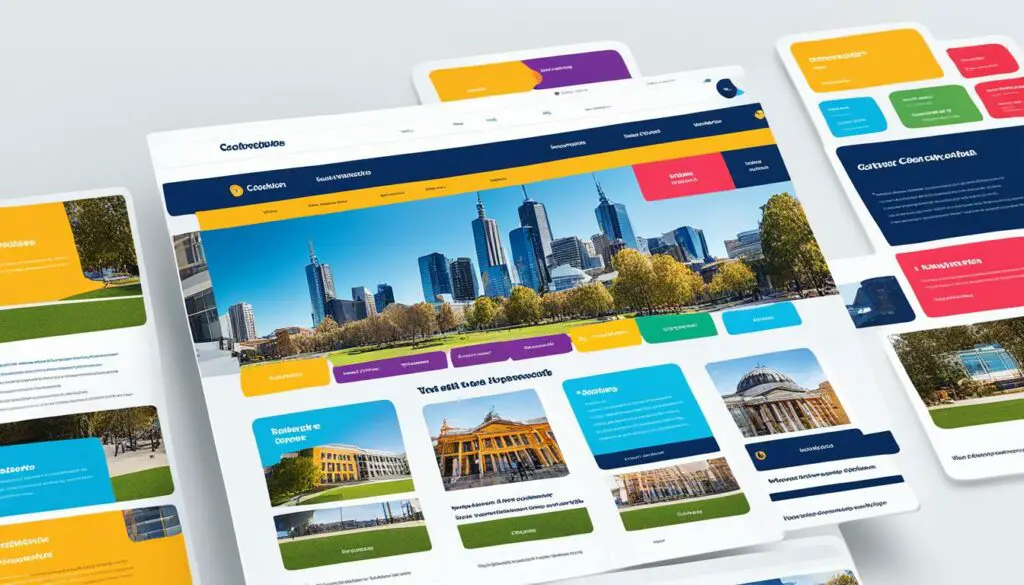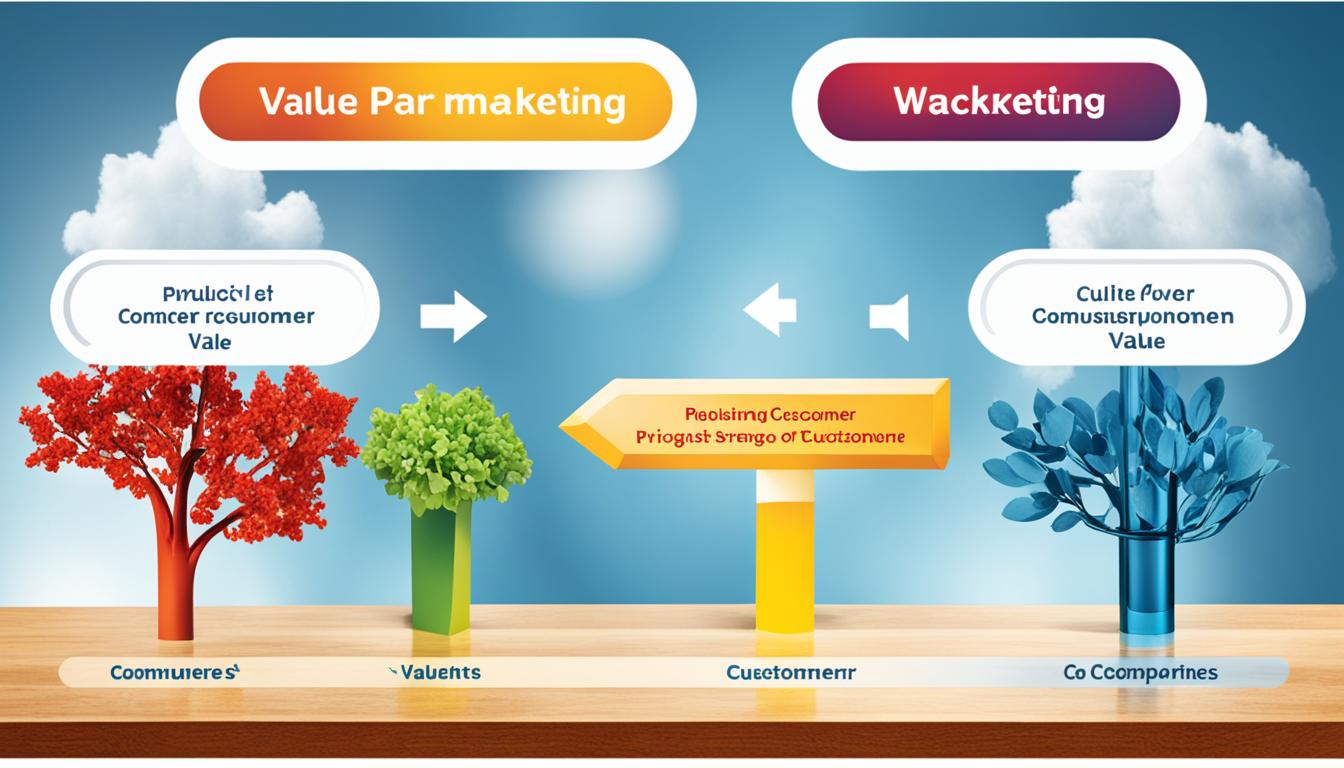Accessibility in marketing refers to designing experiences that meet the needs of all individuals, including those with disabilities. It encompasses various platforms such as websites, emails, and trade shows. By designing for inclusion, marketers can reach a wider audience and comply with legal requirements.
Key Takeaways:
- Accessibility in marketing focuses on designing inclusive experiences for all individuals.
- It includes platforms such as websites, emails, and trade shows.
- Designing for accessibility helps reach a wider audience and comply with legal requirements.
- Accessible marketing improves user experience and fosters inclusivity.
- Implementing accessible advertising strategies is essential for reaching diverse audiences.
The Importance of Accessible Marketing
In today’s digital age, inclusive and accessible marketing has become more crucial than ever. By ensuring that marketing materials are accessible to all individuals, businesses can expand their reach, connect with diverse audiences, and make a positive impact. Accessible marketing goes beyond just meeting legal requirements; it is about creating an inclusive experience where every user can fully engage with a brand’s communication and offerings.
Marketing for all means reaching out to individuals with different abilities, backgrounds, and preferences. By implementing inclusive marketing strategies, businesses can tap into a wider audience and foster a sense of belonging and acceptance. When people feel seen and represented in marketing campaigns, they are more likely to connect with a brand on a deeper level, leading to increased brand loyalty and customer engagement.
Moreover, accessible marketing has a significant impact on brand reputation and perception. When brands prioritize inclusivity and accessibility, they demonstrate a commitment to equality and social responsibility. This resonates with consumers, who increasingly expect brands to align with their values and support causes they care about. By prioritizing accessibility, businesses can enhance their reputation as a brand that is aware, compassionate, and welcoming to all.
Compliance with accessibility requirements is another important aspect of accessible marketing. Many countries have established legal frameworks, such as the Web Content Accessibility Guidelines (WCAG) in the United States and the European Union (EU) Web Accessibility Directive, to ensure digital accessibility. By adhering to these requirements, businesses not only avoid potential legal issues but also ensure that their marketing materials can be accessed and understood by everyone.
Marketing Impact and Business Growth
The impact of accessible marketing extends beyond compliance and brand reputation. It directly contributes to business growth and success. By reaching a wider audience, businesses can increase their online visibility, attract new customers, and drive conversions. Accessible websites, emails, and social media campaigns can capture the attention and engagement of individuals who may have otherwise been excluded from the marketing funnel.
For example, implementing accessible features such as alt text for images, closed captions for videos, and easy navigation for individuals with mobility impairments can improve the overall user experience and create a positive perception of the brand. This, in turn, leads to higher customer satisfaction, increased conversions, and ultimately, business growth.
It is essential for businesses to recognize the importance of accessible marketing and integrate it into their overall marketing strategies. In doing so, they can unlock the potential of reaching diverse audiences, enhancing user experience, and complying with legal requirements. Accessible marketing not only benefits the business bottom line but also creates a more inclusive and equitable society.
The Impact of Accessible Marketing – A Comparative Analysis
| Traditional Marketing | Accessible Marketing |
|---|---|
| Excludes individuals with disabilities | Includes individuals with disabilities |
| Misses out on a significant customer base | Taps into a wider audience and potential customers |
| Risks legal and reputational issues | Complies with accessibility requirements and enhances reputation |
| Delivers a fragmented user experience | Provides an inclusive and seamless user experience |
Understanding Accessible Marketing
Accessible marketing involves utilizing inclusive design practices to create experiences that allow users of all abilities to fully engage with a brand. By focusing on inclusivity, marketers ensure that their brand communication is understandable and provides equal opportunities for engagement and interaction.
Inclusive design practices form the foundation of accessible marketing. This approach emphasizes creating user experiences that prioritize accessibility, usability, and functionality. It means considering diverse user needs and ensuring that the brand’s communication is accessible to all.
One crucial element of accessible marketing is user experience (UX). Brands must strive to provide a seamless experience for all users, regardless of their abilities. This involves optimizing website navigation, ensuring compatibility with screen readers, and providing clear and concise content.
Brand communication plays a vital role in accessible marketing. It’s important to use clear and concise language to convey the brand’s message effectively. Providing alternative formats, such as captions or transcripts for videos, audio descriptions for images, and closed captions for multimedia content, further enhances accessibility.
Engagement opportunities are another essential aspect of accessible marketing. Brands should aim to offer equal opportunities for engagement and interaction, ensuring that all users can participate fully. This can include providing accessible forms, interactive features that are keyboard accessible, and inclusive design in social media campaigns.
Implementing accessible marketing practices not only enhances the inclusivity of a brand, but it also expands its reach to a broader audience. When marketing communications are accessible and inclusive, it creates a positive user experience, fosters brand loyalty, and builds trust among consumers.
Below is an example of how accessible marketing practices can be implemented:
| Accessible Marketing Practice | Description |
|---|---|
| Clear and Concise Language | Use understandable language in all marketing communications to ensure clarity and accessibility for users with various abilities. |
| Alt Text for Images | Include descriptive alt text with all images to provide users with visual impairments the necessary context. |
| Keyboard Accessibility | Design interactive features and forms that can be navigated using a keyboard for users who cannot use a mouse. |
| Accessible Social Media Campaigns | Optimize social media campaigns with clear captions, hashtags, and inclusive design to provide equal opportunities for engagement. |
By incorporating these inclusive design practices and prioritizing accessibility, brands can create a more inclusive marketing experience, ensuring that all users can fully engage with their products and services.
Disabilities and Accessibility Considerations in Marketing
When it comes to marketing, it is essential to consider the diverse needs of individuals with disabilities. Accessible marketing ensures that materials and campaigns are inclusive and accessible to everyone, regardless of impairments in mobility, vision, hearing, speech, or cognition.
To provide equal access, marketers should incorporate various accessibility considerations in their strategies. This includes implementing features such as:
- Audio descriptions: Providing audio descriptions for video content allows individuals with visual impairments to understand and engage with the message.
- Captions: Adding captions to videos and multimedia content ensures that individuals with hearing impairments can follow along and comprehend the information being conveyed.
- Alternative text for images: Including descriptive alternative text for images enables individuals who are unable to see the visuals to understand the context and relevance of the image.
By incorporating these accessibility features, marketers can create an inclusive and engaging experience for individuals with disabilities, fostering a sense of belonging and ensuring that no one is left behind.

Impairments and Marketing Considerations
Let’s take a closer look at some specific impairments and the corresponding accessibility considerations in marketing:
| Impairment | Accessibility Considerations |
|---|---|
| Mobility impairments | Providing accessible navigation and controls for individuals with limited mobility ensures they can easily interact with websites, apps, and other digital marketing materials. |
| Vision impairments | Implementing screen reader compatibility, using high contrast colors, and providing resizable font options improve accessibility for individuals with visual impairments. |
| Hearing impairments | Adding captions or transcripts to audio and video content, as well as utilizing visual cues, enables individuals with hearing impairments to consume and comprehend the marketing message. |
| Speech impairments | Offering alternative communication methods, such as text-based chatbots or chat features, allows individuals with speech impairments to engage in conversations or seek information. |
| Cognitive impairments | Simplifying website layouts and instructions, using clear and concise language, and offering support tools help individuals with cognitive impairments navigate and understand marketing materials effectively. |
Considering these disabilities and incorporating the necessary accessibility considerations in marketing efforts ensures that everyone can fully engage with a brand’s messaging and offerings, fostering inclusivity and expanding the reach of marketing campaigns.
Examples of Successful Accessible Marketing
When it comes to accessible marketing, there are several noteworthy examples that demonstrate how businesses can effectively reach diverse audiences and ensure inclusivity. From accessible websites to social media and email marketing, these examples showcase the importance of implementing accessibility features in various marketing channels.
1. Accessible Website Example: Melbourne Student Life
One impressive example of an accessible website is Melbourne Student Life, a platform that provides information and resources for students in Melbourne University. This website is designed with accessibility in mind, offering features such as alternate text for images and compatibility with screen readers. By incorporating these accessibility features, Melbourne Student Life ensures that all users, including those with visual impairments, can easily access and navigate the website, enhancing user experience.

Image: Accessible Website Example: Melbourne Student Life
2. Social Media Accessibility: Providing Labels for Better Communication
Creating accessible social media marketing involves implementing features that aid users with disabilities in understanding and engaging with content. For example, providing descriptive captions and transcripts for videos allows individuals with hearing impairments to access the information. Additionally, using proper heading structures and alternative text for images improves the readability and understanding of posts for users who utilize screen readers.
3. Email Marketing Accessibility: Proper Formatting and Text Placement
Ensuring email marketing is accessible involves proper formatting and text placement, enabling recipients with disabilities to engage with the content effectively. Simple strategies such as using clear, concise language, avoiding excessive use of jargon, and incorporating descriptive hyperlinks can enhance accessibility for users with visual impairments or cognitive disabilities. Furthermore, optimizing email layouts and using responsive designs support usability across different devices and screen sizes, benefiting users with mobility impairments.
By examining these examples of successful accessible marketing, businesses can gain insights into the best practices for creating inclusive digital experiences. Implementing accessible features and considering the diverse needs of users with disabilities not only demonstrates a commitment to inclusivity but also expands the reach and impact of marketing efforts.
Accessibility Requirements in Different Countries
Ensuring accessibility is not only essential for creating inclusive experiences but also complying with legal requirements. Different countries have implemented accessibility regulations to guarantee equal access to digital content for individuals with disabilities.
United States: Americans With Disabilities Act (ADA)
The Americans with Disabilities Act (ADA) is a comprehensive law that prohibits discrimination against individuals with disabilities in various areas, including employment, public accommodations, and telecommunications. The ADA also applies to digital content, and the Web Content Accessibility Guidelines (WCAG) are referenced as the standard for accessible web design and development.
European Union: Web Accessibility Directive
In the European Union (EU), the Web Accessibility Directive was introduced to ensure that public sector websites and mobile applications are accessible to everyone. Member States are required to adhere to the WCAG as the standard for web accessibility. Additionally, the European Accessibility Act aims to harmonize accessibility requirements for a wide range of products and services, including digital content.
Australia: Disability Discrimination Act 1992 (DDA)
In Australia, the Disability Discrimination Act 1992 (DDA) prohibits discrimination against individuals with disabilities in various domains, including access to goods, services, and facilities. The DDA applies to digital accessibility as well, ensuring that individuals with disabilities can access and use websites, applications, and other digital content.
By adhering to these accessibility requirements, businesses can ensure that their digital content is inclusive and accessible to individuals with disabilities, fostering equal opportunities for engagement and interaction.
| Country | Accessibility Requirements |
|---|---|
| United States | Americans With Disabilities Act (ADA) |
| European Union | Web Accessibility Directive |
| Australia | Disability Discrimination Act 1992 (DDA) |
Implementing accessible design and adhering to these regulations not only benefits individuals with disabilities but also enhances overall user experience and ensures compliance with legal obligations.
Why Accessibility is Important For Your Business
Accessibility is a crucial factor that should not be overlooked when it comes to your business’s online presence. By prioritizing accessibility, you can expand your online reach, increase conversions, ensure legal compliance, and enhance your company reputation.
Expanding Online Reach
By making your digital assets accessible, you open the doors to a larger audience. When your website, emails, and social media posts are designed to accommodate individuals with disabilities, you can provide equal opportunities for engagement and interaction. Expanding your reach to diverse audiences not only fosters inclusivity but also allows you to tap into new market segments and potential customers.
Increasing Conversions
Accessibility plays a crucial role in improving your website’s user experience. When your digital assets are accessible and easy to navigate, users are more likely to stay engaged and take desired actions. By eliminating barriers that may hinder individuals with disabilities from accessing your products or services, you create a seamless and inclusive experience, leading to higher conversion rates.
Legal Compliance
Ensuring accessibility on your digital platforms is not only a matter of good practice but also a legal requirement in many countries. By adhering to accessibility standards, such as the Web Content Accessibility Guidelines (WCAG), you demonstrate your commitment to inclusivity and avoid potential legal issues. Compliance with accessibility regulations helps you maintain a strong legal standing and mitigate potential risks.
Company Reputation
Investing in accessibility demonstrates your commitment to valuing and including diverse individuals. By prioritizing the needs of users with disabilities, you showcase your company’s ethical values and commitment to social responsibility. This can have a positive impact on your company’s reputation, building trust and loyalty among customers, employees, and partners.
By prioritizing accessibility, you can unlock the full potential of your online presence, ensuring that everyone, regardless of their abilities, can access and engage with your brand. With expanded reach, improved user experience, legal compliance, and a positive company reputation, accessibility becomes a crucial element for your business success.
| Benefits of Accessibility for Your Business |
|---|
| Expanded online reach to diverse audiences |
| Increased conversions and improved user experience |
| Legal compliance to avoid penalties and litigation |
| Enhanced company reputation and social responsibility |
Digital Accessibility Requirements
Ensuring digital accessibility is essential for creating an inclusive online experience for all users. To meet these standards, businesses rely on the Web Content Accessibility Guidelines (WCAG) – a set of guidelines that provide a framework for accessible web design and development.
The WCAG focuses on making websites perceivable, operable, understandable, and robust. Let’s take a closer look at what these requirements entail:
Perceivable
A perceivable website ensures that information and content can be perceived by all users, regardless of their abilities. This includes providing alternative text for images, captions for videos, and proper color contrast for text to be easily distinguishable.
Operable
An operable website allows users to navigate and interact with the interface using a variety of assistive technologies. It involves designing clear and logical navigation, ensuring proper keyboard accessibility, and avoiding any content that may cause seizures or other adverse reactions.
Understandable
An understandable website ensures that content and functionality are presented in a clear and predictable manner. This includes using plain language, organizing information in a structured way, and providing clear instructions for tasks or processes.
Robust
A robust website is one that can be interpreted and accessed reliably by a wide range of user agents, including assistive technologies. This involves using valid and accessible code, adhering to web standards, and avoiding technologies that may hinder accessibility.
Compliance with the WCAG guidelines not only ensures a user-friendly website but also helps businesses meet legal requirements and avoid potential litigation related to digital accessibility standards.
Remember, accessible design and development practices benefit all users, creating a more inclusive and engaging online experience. By prioritizing digital accessibility, businesses can enhance their brand reputation, reach a broader audience, and demonstrate their commitment to equal access for all.
Conclusion
Accessibility in marketing plays a crucial role in creating inclusive experiences and reaching diverse audiences. By implementing inclusive marketing strategies and considering the needs of users with disabilities, businesses can expand their reach and have a positive impact. It is essential for marketers to recognize that accessibility is not a one-time effort but an ongoing process that should be incorporated into their future marketing strategies.
By understanding the importance of accessibility in marketing, businesses can ensure that their brand communication is inclusive and accessible to everyone. This not only helps in complying with legal requirements but also opens up opportunities to engage with a wider audience. To achieve accessibility in marketing, it is necessary to adopt inclusive design practices that focus on user experience, addressing impairments in mobility, vision, hearing, speech, and cognition.
Successful accessible marketing examples, such as Melbourne Student Life’s accessible website and properly formatted email marketing campaigns, highlight the positive impact of ensuring accessibility. Considering the specific accessibility requirements of different countries, such as the Americans with Disabilities Act in the United States and the European Union Web Accessibility Directive, is also crucial for businesses operating globally.
In conclusion, accessibility in marketing is not only about legal compliance but also about creating a more inclusive and accessible experience for all users. By embracing inclusive marketing strategies and adopting inclusive design practices, businesses can enhance their online reach, increase conversions, and build a positive company reputation. Emphasizing accessibility is an ongoing commitment that should be integrated into every aspect of marketing strategies to ensure a more inclusive future.
FAQ
What is accessibility in marketing?
Accessibility in marketing refers to designing experiences that meet the needs of all individuals, including those with disabilities. It encompasses various platforms such as websites, emails, and trade shows.
Why is accessible marketing important?
Accessible marketing is crucial for expanding a brand’s reach, growing business, and making a positive impact on diverse audiences. It helps businesses comply with legal requirements in many countries and ensures that all users can fully engage with the brand’s communication and offerings.
How does accessible marketing work?
Accessible marketing involves using inclusive design practices to create experiences that allow users of all abilities to fully engage with the brand. It includes ensuring that brand communication is understandable and providing equal opportunities for engagement and interaction with the brand.
What disabilities and considerations should be accounted for in marketing?
Accessible marketing considers various disabilities, including impairments in mobility, vision, hearing, speech, and cognition. It ensures that marketing materials are accessible through features such as audio descriptions, captions, and alternative text for images.
Can you provide examples of successful accessible marketing?
Successful accessible marketing examples include websites like Melbourne Student Life that offer accessibility features such as alternate text and screen reader compatibility. Social media marketing can be made accessible by providing labels for better communication. In email marketing, proper formatting and text placement can enhance accessibility.
What are the accessibility requirements in different countries?
Different countries have their own accessibility requirements. In the United States, the Americans With Disabilities Act (ADA) prohibits discrimination and cites the Web Content Accessibility Guidelines (WCAG) as a standard. The EU has the Web Accessibility Directive and the European Accessibility Act, while Australia has the Disability Discrimination Act 1992 (DDA).
Why is accessibility important for businesses?
Accessibility is important for businesses as it allows them to reach a larger audience, enhance user experience, and comply with legal requirements. It helps prevent the alienation of users, improves conversion rates, and fosters a positive company reputation.
What are the digital accessibility requirements?
Digital accessibility requirements are guided by the Web Content Accessibility Guidelines (WCAG). These guidelines emphasize making websites perceivable, operable, understandable, and robust. Compliance with WCAG ensures a user-friendly and accessible website.
Why should businesses prioritize accessibility in marketing?
Accessibility in marketing is vital for creating inclusive experiences and reaching diverse audiences. By implementing inclusive marketing strategies and considering the needs of users with disabilities, businesses can expand their reach and have a positive impact. Ensuring accessibility is an ongoing process that should be incorporated into future marketing strategies.







